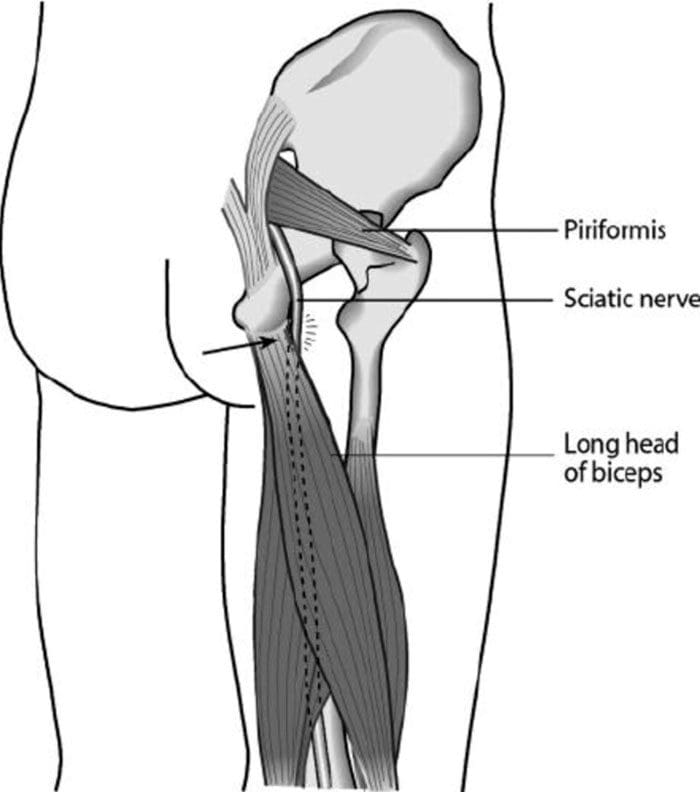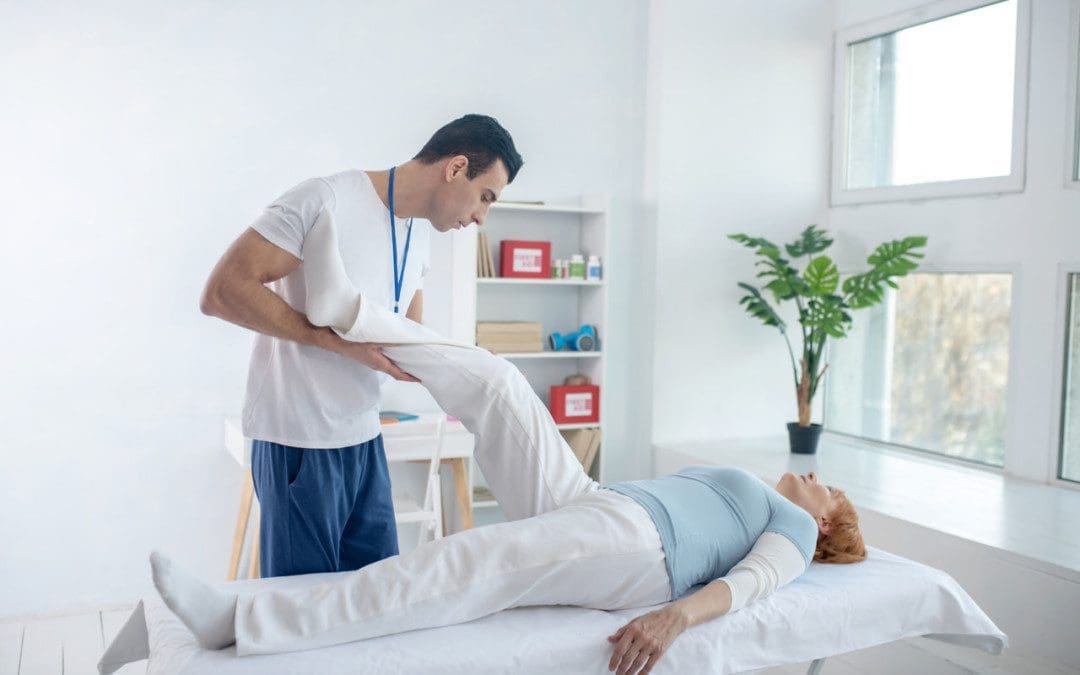The hamstring muscles are three muscles in the back of the thigh. The sciatic nerve goes through or around and down the legs into the feet. Hamstring syndrome is a condition where injury or spasm apply pressure compressing the sciatic nerve.
- The nerve can become pinched between the hamstring muscles and the pelvic bone or the band of tissue that connects the hamstring muscles.
- This can cause discomfort, tingling, numbness, and pain down the back of the leg, hip, buttock, and into the foot.
- Pain can present when sitting down or stretching the hamstrings.
- Pain reduces when lying flat on the back.

Contents
Hamstring syndrome
This condition could be the result of wearing and tearing to the back muscles and hamstring muscles. It is often seen in individuals that play sports involving running, kicking, and/or jumping. But it can happen to anyone from some awkward leg motion causing the muscles to spasm that can twist around the sciatic nerve or pull on it, causing various symptoms. A doctor or chiropractor will diagnose the condition by examining the symptoms, physical activities, and leg. Most individuals diagnosed with hamstring syndrome report discomfort or pain where they sit down. The pain gradually worsens when performing physical activities, regularly sitting, and when flexing the knee. Hamstring syndrome usually gets better within a few weeks with proper rest and home care. A doctor or chiropractor will recommend exercises and stretches to strengthen the muscles.
Home care
- Ask the doctor or chiropractor about taking over-the-counter pain medication:
- Acetaminophen – Tylenol
- Ibuprofen – Advil, Motrin
- Naproxen – Aleve
- Read and follow all label instructions.
- Use an ice pack on the pain area for 10 to 20 minutes at a time.
- Try to do this every 1 to 2 hours for 3 days or until the swelling goes down.
- After 2 or 3 days, if the swelling is gone, apply heat.
- Use a warm water bottle, heating pad, or warm cloth over the area.
- Avoid sitting if possible, unless it feels better than standing.
- Take short walks to keep the muscles stretched.
- Don’t do anything that causes symptoms to worsen.
- Return to normal physical activities slowly.
- If symptoms do not improve, then contact a doctor or chiropractor.
Body Composition
Short-term effects of coffee
- Coffee increases short-term blood pressure slightly.
- Caffeine falls under stimulants, or substances that excite the systems throughout the body.
- Ingesting caffeine can cause the body to experience increased excitement, especially in the cardiovascular system.
- This excitement causes the heart rate and blood pressure to rise
- Then it lowers back down to baseline levels for most healthy individuals.
- It is recommended to drink coffee in moderation, safe for individuals with pre-existing cardiovascular conditions.
References
de Ridder, Roel et al. “Neurodynamic sliders promote flexibility in tight hamstring syndrome.” European journal of sports science vol. 20,7 (2020): 973-980. doi:10.1080/17461391.2019.1675770
Matsuda, Dean K. “Editorial Commentary: Proximal Hamstring Syndrome: Another Pain in the Buttock.” Arthroscopy: the journal of arthroscopic & related surgery: official publication of the Arthroscopy Association of North America and the International Arthroscopy Association vol. 34,1 (2018): 122-125. doi:10.1016/j.arthro.2017.08.260
Park, Jung Wee et al. “Deep gluteal syndrome as a cause of posterior hip pain and sciatica-like pain.” The bone & joint journal vol. 102-B,5 (2020): 556-567. doi:10.1302/0301-620X.102B5.BJJ-2019-1212.R1
General Disclaimer, Licenses and Board Certifications *
Professional Scope of Practice *
The information herein on "Hamstring Syndrome, Sciatica, and Chiropractic" is not intended to replace a one-on-one relationship with a qualified health care professional or licensed physician and is not medical advice. We encourage you to make healthcare decisions based on your research and partnership with a qualified healthcare professional.
Blog Information & Scope Discussions
Welcome to El Paso's Premier Wellness and Injury Care Clinic & Wellness Blog, where Dr. Alex Jimenez, DC, FNP-C, a Multi-State board-certified Family Practice Nurse Practitioner (FNP-BC) and Chiropractor (DC), presents insights on how our multidisciplinary team is dedicated to holistic healing and personalized care. Our practice aligns with evidence-based treatment protocols inspired by integrative medicine principles, similar to those on this site and on our family practice-based chiromed.com site, focusing on naturally restoring health for patients of all ages.
Our areas of multidisciplinary practice include Wellness & Nutrition, Chronic Pain, Personal Injury, Auto Accident Care, Work Injuries, Back Injury, Low Back Pain, Neck Pain, Migraine Headaches, Sports Injuries, Severe Sciatica, Scoliosis, Complex Herniated Discs, Fibromyalgia, Chronic Pain, Complex Injuries, Stress Management, Functional Medicine Treatments, and in-scope care protocols.
Our information scope is multidisciplinary, focusing on musculoskeletal and physical medicine, wellness, contributing etiological viscerosomatic disturbances within clinical presentations, associated somato-visceral reflex clinical dynamics, subluxation complexes, sensitive health issues, and functional medicine articles, topics, and discussions.
We provide and present clinical collaboration with specialists from various disciplines. Each specialist is governed by their professional scope of practice and their jurisdiction of licensure. We use functional health & wellness protocols to treat and support care for musculoskeletal injuries or disorders.
Our videos, posts, topics, and insights address clinical matters and issues that are directly or indirectly related to our clinical scope of practice.
Our office has made a reasonable effort to provide supportive citations and has identified relevant research studies that support our posts. We provide copies of supporting research studies upon request to regulatory boards and the public.
We understand that we cover matters that require an additional explanation of how they may assist in a particular care plan or treatment protocol; therefore, to discuss the subject matter above further, please feel free to ask Dr. Alex Jimenez, DC, APRN, FNP-BC, or contact us at 915-850-0900.
We are here to help you and your family.
Blessings
Dr. Alex Jimenez DC, MSACP, APRN, FNP-BC*, CCST, IFMCP, CFMP, ATN
email: coach@elpasofunctionalmedicine.com
Multidisciplinary Licensing & Board Certifications:
Licensed as a Doctor of Chiropractic (DC) in Texas & New Mexico*
Texas DC License #: TX5807, Verified: TX5807
New Mexico DC License #: NM-DC2182, Verified: NM-DC2182
Multi-State Advanced Practice Registered Nurse (APRN*) in Texas & Multi-States
Multi-state Compact APRN License by Endorsement (42 States)
Texas APRN License #: 1191402, Verified: 1191402 *
Florida APRN License #: 11043890, Verified: APRN11043890 *
License Verification Link: Nursys License Verifier
* Prescriptive Authority Authorized
ANCC FNP-BC: Board Certified Nurse Practitioner*
Compact Status: Multi-State License: Authorized to Practice in 40 States*
Graduate with Honors: ICHS: MSN-FNP (Family Nurse Practitioner Program)
Degree Granted. Master's in Family Practice MSN Diploma (Cum Laude)
Dr. Alex Jimenez, DC, APRN, FNP-BC*, CFMP, IFMCP, ATN, CCST
My Digital Business Card
Licenses and Board Certifications:
DC: Doctor of Chiropractic
APRNP: Advanced Practice Registered Nurse
FNP-BC: Family Practice Specialization (Multi-State Board Certified)
RN: Registered Nurse (Multi-State Compact License)
CFMP: Certified Functional Medicine Provider
MSN-FNP: Master of Science in Family Practice Medicine
MSACP: Master of Science in Advanced Clinical Practice
IFMCP: Institute of Functional Medicine
CCST: Certified Chiropractic Spinal Trauma
ATN: Advanced Translational Neutrogenomics
Memberships & Associations:
TCA: Texas Chiropractic Association: Member ID: 104311
AANP: American Association of Nurse Practitioners: Member ID: 2198960
ANA: American Nurse Association: Member ID: 06458222 (District TX01)
TNA: Texas Nurse Association: Member ID: 06458222
NPI: 1205907805
| Primary Taxonomy | Selected Taxonomy | State | License Number |
|---|---|---|---|
| No | 111N00000X - Chiropractor | NM | DC2182 |
| Yes | 111N00000X - Chiropractor | TX | DC5807 |
| Yes | 363LF0000X - Nurse Practitioner - Family | TX | 1191402 |
| Yes | 363LF0000X - Nurse Practitioner - Family | FL | 11043890 |








